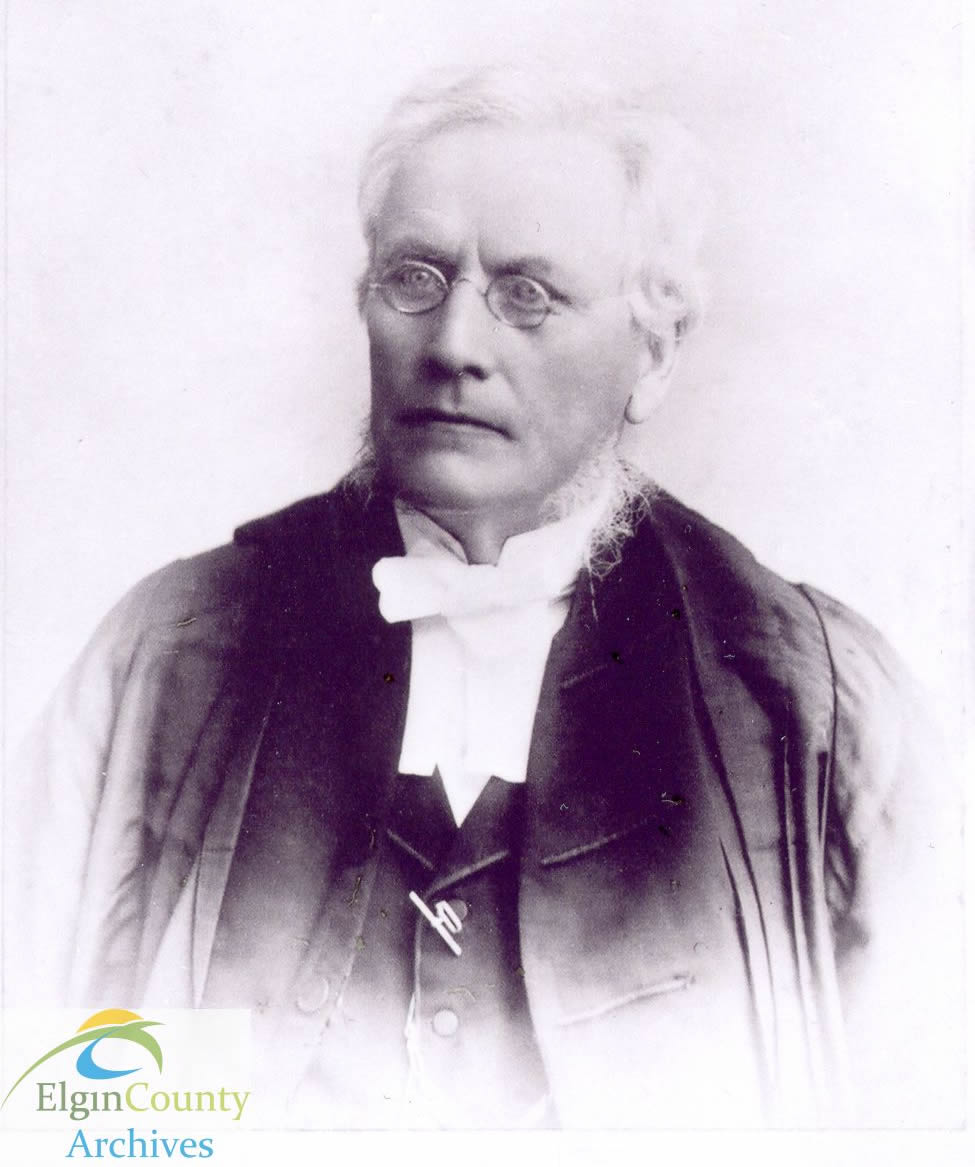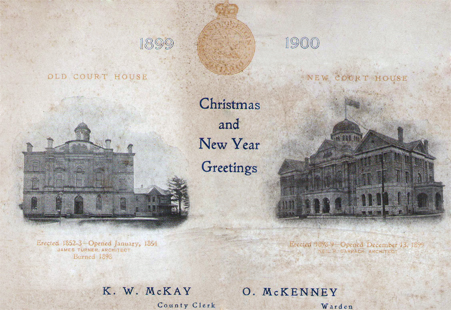Reopening the Courthouse - 1899
The Courthouse was formally opened on Wednesday, December 13, 1899 and was the first day of the Court of General Sessions of the Peace and of the County Court.
The proceedings commenced at 2:40 p.m.  with Judge David John Hughes presiding, with Junior Judge Ermatinger on his right and Sheriff Brown on his left.
with Judge David John Hughes presiding, with Junior Judge Ermatinger on his right and Sheriff Brown on his left.
Present to help with the proceedings were Rev. D. R. Drummond, Professor T. L. Fowler of the Disciples College and Rev. R. I. Warner, principal of Alma College.
Mr. Oscar McKenney, Warden of the County of Elgin, read an address to Judge Hughes on behalf of County Council. In part he read:
“Before proceeding with the business of the County Court and General Sessions of the Peace, the County Council desire to congratulate your Honor on your good health and physical and mental vigor which is remarkable when we consider that you have occupied your present position for over forty-six years. You had the honor of presiding at the first court held in the old buildings in 1854, and have since done much to assist in the development of the county. You have witnessed many changes and can refer to many pleasant experiences which are the accompaniment of a long and useful life. The Court House which we hereby formally hand over to you for Court purposes, is representative of our idea of the advancement made by a wealthy and prosperous community during the past half a century….”
Councillor Frank Hunt delivered the oration of the day on behalf of the County Council. He spoke as follows:
“This is an important occasion. Important because it makes a page in the history of the county. It establishes a milestone marking the progress of a people who first planted civilization in this county a century ago. The burning of the old Court House necessitated the building of a new one, and this gave the present council the opportunity to erect a building characteristic of the people, and of the arts and sciences of this particular period. The old court house was emblematic of the pioneers of this county. It exhibited wisdom, strength and beauty. As much as I admire the new structure I am glad the front of the old court house is preserved, and will hand down to future ages in its Grecian columns and pilasters, the artistic tasted of the pioneers who could spare from the rewards of unceasing toil money to erect a court house that bore the impress of the best art of their time. The excellence and thoroughness of the structure attest the true worth and integrity of the pioneers of the County of Elgin. I cannot but think, when considering the population and wealth of the county fifty years ago with that of to-day, that in the erection of the new court house we have spent less for artistic effect than did the pioneers. Modern requirements for the comfort of those attending courts, or on official business, entailed a large expense which was not considered in the erection fifty years ago. The provision made for women during a forced attendance at court shows how far we have advanced on one particular line. It is a grand building of the utilitarian type, and erected on such lines that great beauty may be discovered by a casual glance. I want to say a word in praise of the architect who designed the building and supervised its erection to the satisfaction of the Building Committee. The epitaph in St. Paul’s Cathedral says: “If you would know the genius of Christopher Wren, look around you.” I will say, also, and it is all that is necessary, if you would know the genius of Mr. Darrach, look around you and see that he is the master of his art….
I cannot close without reference to His Honor Judge Hughes and his long judicial career in the County of Elgin. He opened the old court house forty-six years ago: he has been spared to open the new. In the first courts he grasped by the hand the men who planted civilization on the shores of Lake Erie. He has lived to grasp by the hand their children and grand-children. He came here in his early years, a type of that manhood which comes from the chisel of Pericles, and the great masters of the Grecian school. He has seen the county a wilderness, he now sees it a populous and wealthy, inhabited by a people educated, industrious: a people who love God and keep his commandments….”
 The work on the courthouse was completed in the spring of 1900. The final report from the Building Committee was presented November 23, 1900. The total cost was $50,954.72. The city of St. Thomas contributed $12,178.17 to this.
The work on the courthouse was completed in the spring of 1900. The final report from the Building Committee was presented November 23, 1900. The total cost was $50,954.72. The city of St. Thomas contributed $12,178.17 to this.
